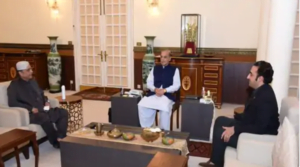
Unveiling Pakistan’s Political Pandemonium: Shocking Election Revelations Await!
Exploring the Aftermath of Pakistan’s National l Assembly and Provincial Elections The results are coming after the end of voting for the National Assembly and provincial elections in Pakistan have stirred the political landscape with their intriguing outcomes. As the dust settles, the nation awaits the formation of a new government amidst a myriad of challenges and controversies. Let’s delve into the intricacies of these elections and their aftermath.
- Understanding the Electoral Landscape
The results are coming after the end of voting for the National Assembly and provincial elections in Pakistan have showcased a diverse political panorama marked by a lack of majority. With independent candidates loyal to Imran Khan leading with 99 seats and Nawaz’s party trailing behind with 71 seats, the race for power is intense and uncertain. - Unraveling the Political Turmoil
The aftermath of the elections has been marred by violence, particularly in provinces like Khyber Pakhtunkhwa. Allegations of rigging from imprisoned leaders such as Imran’s PTI and Bilawal’s PPP add fuel to the fire, casting a shadow of doubt over the legitimacy of the results. - The Dynamics of the National Assembly
Pakistan’s National Assembly comprises 336 seats, with elections held in 265 seats and one seat postponed. The remaining 70 seats are reserved, necessitating a majority of 134 seats to form the government. The competition primarily involves three major parties: Pakistan Muslim League-Nawaz (PML-N), Pakistan Tehreek-e-Insaf (PTI), and Pakistan Peoples Party (PPP). - Unveiling Election Results
Results were announced for 250 out of 265 seats, reflecting a partial yet significant revelation of the electorate’s preferences. However, the outcome of the remaining seats holds the key to shaping the country’s political trajectory in the days to come. - Analyzing the Implications
The aftermath of Pakistan’s elections reverberates across various sectors, influencing both domestic and international affairs. - Political Instability and Governance Challenges
The absence of a clear majority poses formidable challenges for governance, raising concerns about political stability and effective decision-making. The need for coalition-building and consensus among divergent political entities becomes paramount in such a scenario. - Economic Uncertainty
Political instability often correlates with economic uncertainty, deterring foreign investment and impeding economic growth. The prolonged uncertainty following the elections could exacerbate existing economic challenges, necessitating swift and decisive action from the incoming government. - Social Cohesion and Security
The prevailing political turmoil may also impact social cohesion and security, potentially fueling unrest and discord within the populace. Addressing these concerns requires a concerted effort from all stakeholders to prioritize peace-building initiatives and ensure the safety and well-being of citizens. - What are the key highlights of Pakistan’s recent elections?
The recent elections in Pakistan have highlighted the lack of a clear majority, with independent candidates loyal to Imran Khan leading with 99 seats and Nawaz’s party securing 71 seats. However, allegations of rigging and violence have clouded the electoral process, leading to heightened tensions. - How many seats are there in Pakistan’s National Assembly?
Pakistan’s National Assembly comprises a total of 336 seats, with elections held in 265 seats and one seat postponed. The remaining 70 seats are reserved for women and minorities. - Which parties are involved in the electoral competition?
The electoral competition in Pakistan primarily involves three major parties: Pakistan Muslim League-Nawaz (PML-N), Pakistan Tehreek-e-Insaf (PTI), and Pakistan Peoples Party (PPP). These parties vie for control over key constituencies to secure a majority in the National Assembly. - What are the implications of the election results for governance?
The lack of a clear majority poses challenges for governance, requiring coalition-building and consensus among divergent political entities. This could potentially impact policy implementation and decision-making processes, leading to concerns about political stability and effective governance. - How has the aftermath of the elections affected social cohesion?
The aftermath of the elections has raised concerns about social cohesion, particularly amidst allegations of rigging and instances of violence. Ensuring peace and harmony within the society necessitates concerted efforts from all stakeholders to address grievances and uphold democratic principles. - What measures can be taken to address the challenges posed by political instability?
Addressing political instability requires proactive measures such as fostering dialogue, promoting inclusivity, and strengthening democratic institutions. Additionally, prioritizing economic reforms and social development initiatives can help mitigate the adverse effects of political uncertainty on the populace.
The aftermath of Pakistan’s National Assembly and provincial elections underscores the intricacies and challenges inherent in the democratic process. As the nation navigates through this period of uncertainty, fostering unity, resilience, and commitment to democratic values is paramount for steering towards a brighter and more prosperous future.